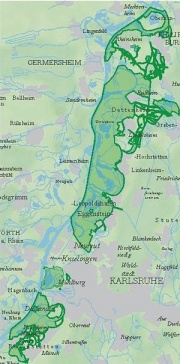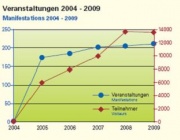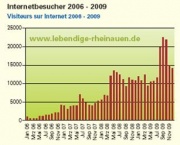Karlsruhe – Living Rhine floodplain near Karlsruhe (LIFE04 NAT/DE/000025)
Karlsruhe – Living Rhine floodplain near Karlsruhe (LIFE04 NAT/DE/000025)
This webpage is currently under construction. Comments with regards to the contents or possible lack would be gratefully appreciated.
The FORECASTER Team
Key features of the case study
In the following section, background and motives of the restoration project which led to the initiation of the project are introduced
Drivers and pressures
In order to allow shipping along the river, the Rhine was channelized in the early 19th century cutting off large meander bends in the floodplains around the city of Karlsruhe. As a consequence, the former floodplain didn’t remain exposed to the natural flood regime of the river (active floodplain) thus preventing natural processes such as lateral erosion and deposition. Besides, the current floodplains uses have led to serious floodplain habitats degradation; most of the natural floodplain forest was replaced by hybrid poplars, thus leaving only small relicts of willow stands (Salix alba and Populus nigra). Numerous gravels pits were also dredged and a network of drainage canals covered the former floodplain. Despite human intervention, nature values remained in some sites of the floodplain and could qualify for Natura 2000, such as former tributaries and side channels of the Rhine River, wet meadows and calcareous fens and woodland subjected to summer floods where protected species such Cladium mariscus, Carex davallania and Callimorpha quadripuncturia occur.
In order to protect those remaining threatened habitats along the Rhine River, a LIFE project were implemented in 2004. The restoration at Karlsruhe was undertaken in the framework of the LIFE project Rheinauen Karlsruhe among five others restoration sites Rheinstetten, Eggenstein-Leopoldshafen, Linkenheim-Hochstetten, Dettenheim and Philippsburg. The project area is introduced in the figure below.
Global objectives
Although river dykes had to remain in place for navigation purposes, the LIFE project aimed to support and to develop both active and former floodplain habitats and to improve their connectivity. Particular attention foresaw to reverse the silting up process of former river arms as well as boosting water flow through the extensive ditch system so that this would act as an interconnecting network linking floodplain and wetlands.
Specific goals
The Karlsruhe restoration aimed to:
- Enhance morpho-dynamic processes by reconnecting the Rhine channel to the floodplain and by removing flow barriers in the inundation area
- Restore the lateral connectivity between the river channel and floodplain waterbodies enabling an exchange of the aquatic fauna
- Restore natural habitats to enhance species conditions
Site description
Measures selection
The following section introduces which measures were prepared, implemented and whether they were successful in reaching their related goals
Under the LIFE project Rheinauen Karlsruhe – Living Rhine floodplain near Karlsruhe, more than hundreds measures were carried out improving 38 km of streams and an area of 7.485 ha.
At Karlsruhe, three different restoration measures were implemented. First of all, a short reach of a dike were opened at the mouth of the tributary Alb allowing fish to access to new spawning areas in the adjacent floodplain area. Secondly, small water bodies (ponds) were established to create habitats mainly for Rana arvalis and Leucorrhinia caudalis. Finally, drainage canals were structured into suitable habitats for fishes and Hyla arborea around the hydrocarbon harbor.
Success criteria
No information found
Ecological response
At many sites of the LIFE project, habitat improvement and spreading of endangered species were observed within the first years after restoration implementation. But the real restoration impact could not be evaluated yet since it will take several decades before the ecosystem will recover (especially natural floodplain forests).
Nevertheless, at the mouth of the tributary Alb, the existing sluice in the dike still represented a migration barrier even though young pikes and spined loaches were observed. As a follow-up project the construction of a new structure was started in June 2010 which would allow free migration (finishing date: summer 2011, costs: 1.6 mio Euro). Besides, the creation of a pond at the Fritschlaic led to important specie enhancements. Only two years after the creation (in 2007), 37 different dragonfly species were observed. 20 species were successfully reproducing, including the rare dragonfly species Gomphus pulchellus and Leucorrhinia caudalis.
Hydromorphological response
Monitoring before and after implementation of the project
The global LIFE project carried a biotic monitoring programme including vegetation, fish, mollusca, dragonflies, amphibians, birds, butterflies and small mammals (bats and specific tree bugs).
Socio-economic aspects
In the following section, ways of cooperation, interaction and information with partners, stakeholders and wider audience of the project are introduced as well as their related success in reaching their participation objectives.
Cooperation
To improve the Upper Rhine management network, the project gathered 16 partners (listed below) from local authorities to nature conservancy authority, water authority, fisheries management authority, nature conservancy associations, fishery associations and research institute.
- Städte Karlsruhe, Philippsburg, und Rheinstetten
- Gemeinden Dettenheim, Eggenstein-Leopoldshafen und Linkenheim-Hochstetten
- Regierungspräsidium Karlsruhe, Referat 53.1 Landesbetrieb Gewässer und Referat 33 Fischereibehörde
- Regierungspräsidium Freiburg, Referat 82 Forstpolitik und Forstliche Förderung Nord
- Naturschutzzentrum Karlsruhe-Rappenwört
- Forschungszentrum Karlsruhe
- Bund für Umwelt und Naturschutz Deutschland (Ortsverband Rheinstetten)
- Naturschutzbund Deutschland (Gruppe Karlsruhe)
- Verein für Vogel- und Naturschutz Dettenheim
- Sportfischervereinigung Eggenstein
- Anglervereine Leopoldshafen
- Anglervereine Linkenheim
Interaction
No information found.
Communication
Besides ecological restoration goals, the project foresaw to carry an information and awareness campaign targeting a wide audience. Therefore, several communication means were undertaken such as articles into the local news media, publications, web cams, development of a mobile electronic guide, guided tours as well as seminars, information boards, website etc. The two following figures list the means used for the project communication and highlights an important public participation in the project.
Funding
The following section gives an overview of cost and funding of the project
Cost: 7,000,000.00 € Euros
European Union: 50%
Local authorities: 18 %
Regional authorities (Regierungspräsidium Karlsruhe and RP Referrat Gewasser): 16 + 11.5 %
Forest agency ( Landesforstverwaltung): 1.5 %
Others: 2 %
NGOs: 1 %
Contact person within the organization
Regierungspräsidium Karlsruhe
Peter ZIMMERMANN, project manager/coordinator
Telephone: +49 721 926 43 76
E-mail: Peter.zimmermann@rpk.bwl.de
Extra background information
References
- Regierungspräsidium Karlsruhe website
- Rheinauen Karlsruhe – Living Rhine floodplain near Karlsruhe (language: English)
- LIFE -Projekt “ Lebeindige Rheinauen – Lebensraume fur Mensch und Natur (language: German/French)
- LIFE -Projekt “ Lebeindige Rheinauen – Ergebnisse (language: German/French)
- Lebendige Rheinauen bei Karlsruhe - Technischer Bericht (language: english, abstract)
- Lebendige Rheinauen bei Karlsruhe – Poster (language: English)
Related Measures
Related Pressures
- Hydrological regime modification
- Channelisation / cross section alteration
- Alteration of riparian vegetation
- Sand and gravel extraction
- Loss of vertical connectivity



